
Billboard Greatest Christmas Hits
various artists
Support www.hipchristmas.com! ![]() Shop at Amazon, Apple Music, and more...
Shop at Amazon, Apple Music, and more...
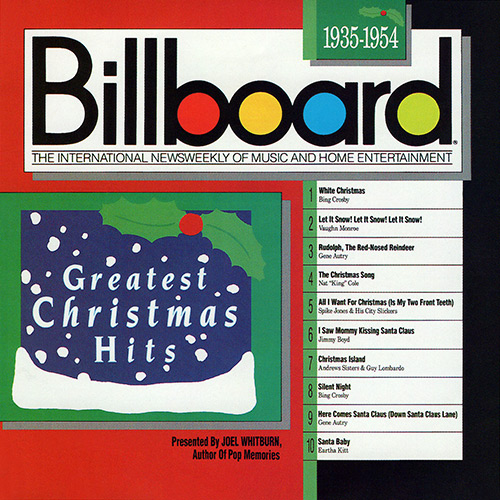 In
the late 1980's and early 1990's, Rhino Records partnered with Billboard Magazine, the music industry's
leading trade journal, to produce a long series of budget-priced compact discs called Billboard Top Hits. Lucky for us, the series also included seven volumes of holiday music under the banner Billboard Greatest Christmas Hits: two for pop and one each for country, rhythm 'n' blues, rock 'n' roll, children's, and religious music. By definition, most consisted exclusively of top chart hits - the most popular songs, but not necessarily the best. They were brief - just 10 tracks, less than half the capacity of a CD - and minimally illustrated and annotated. But, they were cheap, and if you wanted the hits, you got 'em.
In
the late 1980's and early 1990's, Rhino Records partnered with Billboard Magazine, the music industry's
leading trade journal, to produce a long series of budget-priced compact discs called Billboard Top Hits. Lucky for us, the series also included seven volumes of holiday music under the banner Billboard Greatest Christmas Hits: two for pop and one each for country, rhythm 'n' blues, rock 'n' roll, children's, and religious music. By definition, most consisted exclusively of top chart hits - the most popular songs, but not necessarily the best. They were brief - just 10 tracks, less than half the capacity of a CD - and minimally illustrated and annotated. But, they were cheap, and if you wanted the hits, you got 'em.
Before we proceed, a few points of order. If you have a copy of Joel Whitburn's book Christmas In The Charts 1920-2004, a document of every Christmas song that ever made the Billboard charts, it includes several lists (starting on page 77) that closely - but not completely - align with these Rhino compilations. Whitburn himself is credited with curating the Rhino collections, but without explanation, several top hits are missing. These include Merle Haggard's "If We Make It Through December" (#1 Country), Lowell Fulson's "Lonely Christmas" (#10 R&B), and the Carpenters' "Merry Christmas Darling" (#5 Christmas). I can only guess that those tracks were unavailable for licensing at the time. In other cases, the charts overlap, often in ways that don't make much sense thematically. For instance, several songs appear on both the pop and R&B charts and, thankfully, they aren't duplicated on the Rhino series: Bing Crosby's "White Christmas," Nat King Cole's "Christmas Song," and David Seville's "Chipmunk Song" (yes, the Chipmunks made the R&B chart).
But then, some songs are, indeed, present on more than one volume. Specifically, Bobby Helms' "Jingle Bell Rock" appears on both Greatest Christmas Hits 1955-Present and Greatest Country Christmas Hits, Jimmy Boyd's "I Saw Mommy Kissing Santa Claus" appears on both the Country volume and Greatest Christmas Hits 1935-1954, and "The Chipmunk Song" shows up on both 1955-Present and Family Christmas Classics. Even more disconcerting, some songs seem to parachute in wherever Rhino felt like dropping them. For instance, the Drifters' "White Christmas was a #2 R&B hit in 1954, while it barely registered on the pop charts, but it appears only on Christmas Hits 1955-Present - and not on the R&B volume. Meanwhile, Brook Benton's "This Time Of The Year" was a pop hit, but it's included on Greatest R&B Christmas Hits - maybe because he was black?
I found myself asking, are these inconsistencies the result of questionable methodology, or was it simple incompetence from the normally stalwart Rhino staff? Or worse, Whitburn himself? Who knows. Sit back and enjoy the music, I guess, and don't think too hard.
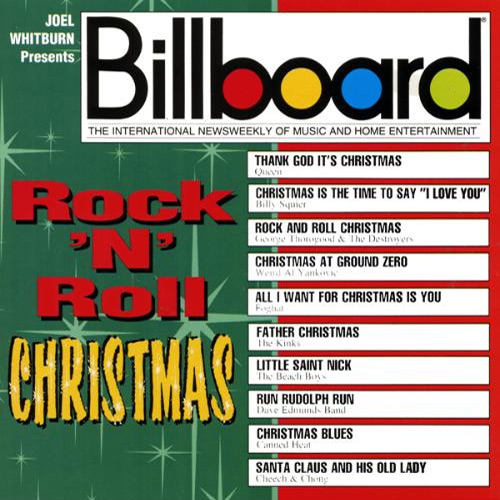 The Girl Can't Help It
The Girl Can't Help It
Rock 'n' roll is my raison d'être, so it was Billboard Rock 'n' Roll Christmas (1994) that first drew me to the series. Something of an afterthought to the original series, Rock 'n' Roll Christmas ventured farther afield and, in the process, created one of the best collections of its kind - at the time, at least. Note that the word "hits" doesn't appear in the title and, indeed, none of the tracks registered on Billboard's pop chart. A few made the Christmas chart, and one of them charted only in the UK. Several weren't hits at all, and two weren't even released commercially in the United States. But, they were (mostly) fine rock songs by noteworthy rock artists - most from the post-Beatles "classic rock" era. Like the other Billboard volumes, Rock 'n' Roll Christmas contained just 10 tracks, but nine of those tracks approached or achieved greatness, and most of them were hard to find (again, at the time, at least).
Four of the tracks appear in my Top 100 Christmas Songs: the Beach Boys' "Little Saint Nick" (1963), Billy Squier's "Christmas Is The Time To Say I Love You" (1981), the Kinks' "Father Christmas" (1977), and George Thorogood's "Rock And Roll Christmas" (1983). And, the songs by Foghat, Queen, Canned Heat, and Dave Edmunds (updating Chuck Berry's timeless "Run Rudolph Run") are fine rockers, too. Meanwhile, Cheech & Chong's "Santa Claus & And His Old Lady" isn't even a song - it's a comedy skit - but it was required listening for stoners of a certain age.
Nevertheless, I banished Rock 'n' Roll Christmas from my Top 20 Albums solely on the basis of Weird Al Yankovic's "Christmas At Ground Zero" - an indefensible selection. Mildly funny, it's a better video than a song, and the joke hasn't aged well since the Cold War ended in 1989. Note that it's an original song, not a parody of a popular hit, and it illustrates why Mr. Yankovic made his living as a parodist, not a songwriter. Moreover, it's a heavily synthesized mess. Like a lot of Weird Al's greatest hits, it simply doesn't bear up under repeated listening.
 The (Sort Of) Pop Hits
The (Sort Of) Pop Hits
The first two volumes of Rhino's Billboard Christmas series are generally less essential for people who value holiday music that rocks, rolls, swings, or twangs. But, they are by definition chock full of hits. Released in 1989, Billboard Greatest Christmas Hits 1935-1954 and Billboard Greatest Christmas Hits 1955-Present more closely mirrored the rest of the series, which was organized chronologically, not thematically. And, these were literally the biggest Christmas hits on the Billboard charts - a purely democratic, if less compelling, concept. They include mostly pop music, but also country (Gene Autry), rhythm 'n' blues (Charles Brown), and rock (Elvis Presley), plus a few novelties like Spike Jones's "All I Want For Christmas (Is My Two Front Teeth)." The liner notes are annotated and illustrated, but not lavishly so.
All 10 tracks on Greatest Christmas Hits 1935-1954 are essential from one perspective or another. All were Top 10 hits, and all the artists were household names at the time - even if a few are lost to history (where have you gone, Vaughn Monroe?). It stretches from Bing Crosby's first holiday recording, "Silent Night" - a sonorous, yet historically significant reading from 1935 - to Eartha Kitt's saucy 1953 single "Santa Baby" - a horny classic from any perspective. Collectors should note that the 1946 recording of "The Christmas Song" by the Nat King Cole Trio is an early version recorded two months prior to the revered Capitol master. By all appearances, Rhino used this previously unreleased rarity by accident. It's fascinating to hear, but both the recording quality and the Trio's performance are considerably less polished than the final product.
Again, all 10 tracks on the next volume, Greatest Christmas Hits 1955-Present, are essential from some perspective, if only for their popularity. The album picks up as the rock 'n' roll era begins, so foundational songs like Bobby Helms' "Jingle Bell Rock" (1957) and Brenda Lee's "Rockin' Around The Christmas Tree" (1958) are included, as well the Drifters' amazing doo wop transformation of "White Christmas." It's worth noting, though, that the album's title is basically a misnomer. As established, the Drifters track came out in 1954, which makes me think that someone at Rhino flunked basic math: 1954 is less than 1955, though the song charted again almost every year for more than a decade. More profoundly, the "present" would have been 1989 - the year the album was released - and yet it runs out of gas in 1960. The only song on the album released after 1960 is the 1979 novelty "Grandma Got Run Over By A Reindeer," which, personally, I'd rather forget.
[close]
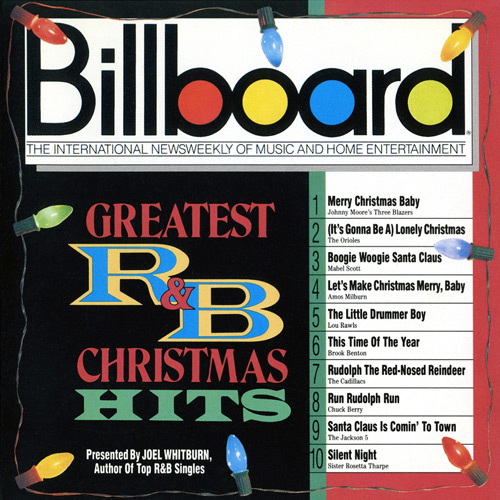 This is a telltale sign of the long decline in popularity that Christmas music would experience. The years following 1960 would see sweeping changes and upheaval around the world, musically and culturally. In the age of the Beatles, Dylan, and Hendrix, as well as the civil rights struggle and the Vietnam War, Christmas music fell out of fashion. It became music for squares, though exceptions exist - Paul Revere & The Raiders' Christmas Present, for instance, and the monumental series of Motown Christmas albums. But, when Greatest
Christmas Hits 1955-Present was released in 1989, holiday music was just beginning its commercial recovery - kickstarted by the Very Special Christmas series that began in 1987. In the coming age of the internet, Christmas music became an annual mania all over again, celebrating holiday music new and old, hip and square.
This is a telltale sign of the long decline in popularity that Christmas music would experience. The years following 1960 would see sweeping changes and upheaval around the world, musically and culturally. In the age of the Beatles, Dylan, and Hendrix, as well as the civil rights struggle and the Vietnam War, Christmas music fell out of fashion. It became music for squares, though exceptions exist - Paul Revere & The Raiders' Christmas Present, for instance, and the monumental series of Motown Christmas albums. But, when Greatest
Christmas Hits 1955-Present was released in 1989, holiday music was just beginning its commercial recovery - kickstarted by the Very Special Christmas series that began in 1987. In the coming age of the internet, Christmas music became an annual mania all over again, celebrating holiday music new and old, hip and square.
All that said, two other tracks on Greatest Christmas Hits 1955-Present were released after 1960, but they don't count. First, Rhino used the 1965 remake of Harry Simeone's 1958 hit, "The Little Drummer Boy" - something they acknowledge in the liner notes. But, Rhino also picked the obscure 1970 Jewel Records version of Charles Brown's "Please Come Home For Christmas" instead of the hit 1960 King recording - and the liner notes don't reflect that. The Jewel master is a harder-to-find recording, so collectors rejoice, but this seems like another accident in programming (plus, Rhino dates the song as 1961, which is also wrong according to Whitburn's book).
Country and Rhythm & Blues Hits
Hits are hits, and I love "The Chipmunk Song" as much as the next guy, but Billboard Greatest Country Christmas Hits and Greatest R&B Christmas Hits, both released in 1990, are much more to my liking. They are also chock full of hits, but most were restricted to Billboard's Country and Rhythm & Blues charts during an age when genre "crossover" was largely ignored for cultural reasons, if not outright prejudice.
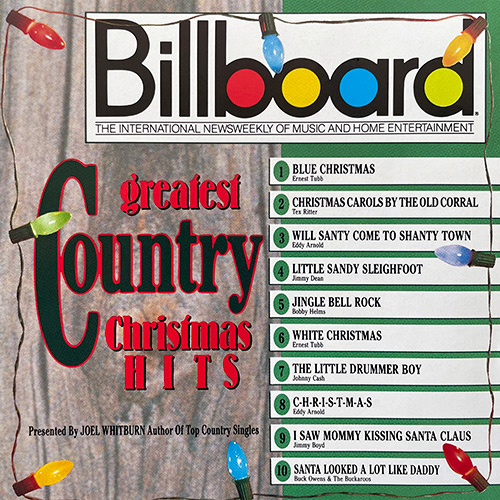 Greatest
Country Christmas Hits starts off in 1945 with Tex Ritter's "Christmas Carols By The Old Corral," though he was as much of an actor as a singer, starring in dozens of "horse operas" as a singing cowboy. The real cornerstones are four Top 10 songs that comprise both sides of two 1949 singles. The first is a Decca single by the Texas Troubadour Ernest Tubb, his signature song, "Blue Christmas," backed by his version of Bing Crosby's "White Christmas." The second is an RCA single by the Tennessee Plowboy Eddy Arnold, "Will Santa Come To Shanty Town" b/w "C-H-R-I-S-T-M-A-S."
Greatest
Country Christmas Hits starts off in 1945 with Tex Ritter's "Christmas Carols By The Old Corral," though he was as much of an actor as a singer, starring in dozens of "horse operas" as a singing cowboy. The real cornerstones are four Top 10 songs that comprise both sides of two 1949 singles. The first is a Decca single by the Texas Troubadour Ernest Tubb, his signature song, "Blue Christmas," backed by his version of Bing Crosby's "White Christmas." The second is an RCA single by the Tennessee Plowboy Eddy Arnold, "Will Santa Come To Shanty Town" b/w "C-H-R-I-S-T-M-A-S."
After that, Greatest Country Christmas Hits highlights four tracks from the 1950's, including Boyd's "I Saw Mommy Kissing Santa Claus" and Helms' somewhat incongruous "Jingle Bell Rock" (I mean, "rock" is right there in the title), before concluding with Buck Owens' "Santa Looked A Lot Like Daddy," the 1965 lead single from the first of two fine Christmas albums Owens recorded in the second half of the 1960's. Interestingly, Owens' song is essentially a reimagining of Boyd's hit - but way faster and a lot more twangy. And then, we're done - nearly a quarter century before the album's release. It's another tacit confession that Christmas music had fallen out of favor - even in the conservative world of country music.
I consider all of the songs on Greatest Country Christmas Hits to be essential listening except one: the aforementioned cover of "White Christmas" by Ernest Tubb. The reasons are two-fold. First, the 1949 version is a by-the-numbers sing-along with Tubb's female backing vocalists, the Troubadourettes. No big whoop. Second, Tubb previously waxed a little-known version of the song in 1947 that makes the Decca master sound pale in comparison - and that's the essential version. Recorded with just Ernest and his band, the Troubadors, it's a longer and way more "country" arrangement with abundant steel guitar. First released on Bear Family's 8-CD box, Walking The Floor Over You (1996), which covers the years 1936 to 1947, this superior early version of Tubb's "White Christmas" later popped up on Bear Family's Christmas On The Range (2020), which inexplicably dates the song as 1950.
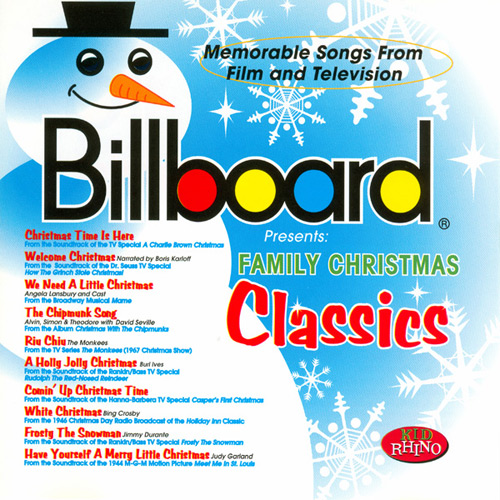 Meanwhile, Greatest
R&B Christmas Hits is, arguably, the best of the Billboard bunch: 10 swingin' classics, short and sweet. It kicks off with the 1947 original version of the all-time classic "Merry Christmas Baby" by Johnny Moore's Three Blazers featuring Charles Brown. He would record the song over and over again - including his definitive 1956 recording for Aladdin - but the original version retains its charms.
Meanwhile, Greatest
R&B Christmas Hits is, arguably, the best of the Billboard bunch: 10 swingin' classics, short and sweet. It kicks off with the 1947 original version of the all-time classic "Merry Christmas Baby" by Johnny Moore's Three Blazers featuring Charles Brown. He would record the song over and over again - including his definitive 1956 recording for Aladdin - but the original version retains its charms.
After that, the hits just keep on coming. More than half of the tracks qualified for my Top 100 Christmas Songs, and the rest were in the running - the Orioles' doo wop masterpiece "(It's Gonna Be A) Lonely Christmas" and Mabel Scott's irresistible "Boogie Woogie Santa Claus" foremost among them. Chuck Berry's motorvatin' "Run Rudolph Run" isn't really rhythm 'n' blues - it's four-on-the-floor rock 'n' roll - but I'm not complaining. Yet once again, Greatest R&B Christmas Hits peters out after the 1950's. It includes just two subsequent releases, both of which registered on Billboard's Christmas chart, but not the R&B chart: Lou Rawls' sly 1967 interpretation of "The Little Drummer Boy" and the Jackson 5's spirited 1970 take on "Santa Claus Is Coming To Town," one of the last Motown Christmas classics.
The only real flaw of Greatest R&B Christmas Hits - like the rest of the Billboard series - is its brevity. Exploring the world of rhythm 'n' blues Christmas music is a rich, rewarding exercise. If you'd like to go further, I'd recommend more Charles Brown, anything by James Brown, Ray Charles, or Booker T. & The MG's, mining the vaults of Motown, Atlantic, and Stax, and picking up Rhino's Hipsters' Holiday, Doo Wop Christmas, and Blue Yule collections. And that's just the cream of the crop...
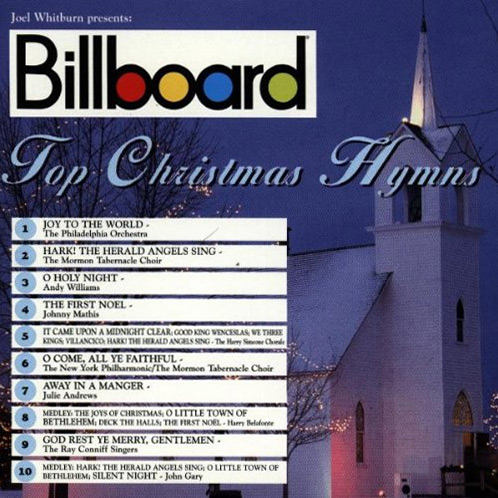 And Now For Something Completely Different
And Now For Something Completely Different
The final two volumes of the Billboard series, Billboard Presents Family Christmas Classics and Billboard Top Christmas Hymns, were released in 1995. They will be of far less interest to most hipsters, and neither conforms very closely to the "Greatest Christmas Hits" concept. Family Christmas Classics ranges from a #1 hit record ("The Chipmunk Song") to several songs that weren't even released as singles, including an obscure song from a soundtrack that was released only on VHS tape (Casper's First Christmas).
That said, Family Christmas Classics ends up being a pretty solid collection of tunes despite the fact that it is aimed primarily at children. It mixes perennial favorites with tracks from cartoons and TV specials, including pop classics like Angela Lansbury's 1966 Broadway recording of "We Need A Little Christmas" and Judy Garland's original 1944 soundtrack version of "Have Yourself A Merry Little Christmas." And, who can argue with Vince Guaraldi's "Christmas Time Is Here" from A Charlie Brown Christmas or "Welcome Christmas" from How The Grinch Stole Christmas? Two songs, however - Jimmy Durante's "Frosty The Snowman" and Burl Ives' "Holly Jolly Christmas" - are included in their inferior TV soundtrack versions rather than earlier, superior original studio recordings.
Plus, Family Christmas Classics has a couple of rarities. Bing Crosby's "White Christmas" is a 1946 "Philco Radio Time" broadcast, though the arrangement is virtually identical to the more common 1942 and 1947 studio recordings. And, the Monkees' "Ríu Chíu" is a Spanish Christmas carol sung a cappella on the 1967 Christmas episode of their influential television show. It's a safe assumption that they learned it from their producer, Chip Douglas, who had recorded it himself in 1964 as a member of the Modern Folk Quartet. However, the Monkees' studio recording of the song - which purportedly includes Douglas' vocals - was not released commercially until their 1990 rarities collection, Missing Links Vol. 2.
But, if Family Christmas Classics seems less impressive than its hit-laden companion volumes, Top Christmas Hymns makes Family Christmas Classics look like a cavalcade of stars. As a collection of religious carols, it's of little interest to me. If you feel differently, go with God. Having said that, most of the tracks are sung by well-known pop stars like Andy Williams, Harry Belafonte, Julie Andrews, and Johnny Mathis, so they aren't much different than the rest of the tracks on the Billboard albums - just more boring. Several tracks, however, are orchestral or choral arrangements by artists like the Mormon Tabernacle Choir, and it doesn't get much less hip than that.
Postscript
A few years later, Rhino released Billboard Christmas Five-Pack (1998), which was no more than five previous volumes in a slipcover, but for a reduced price. What a deal, right? Well, the first four volumes in the package were Greatest Christmas Hits 1935-1954, Greatest Christmas Hits 1955-Present, Greatest Country Christmas Hits, and Greatest R&B Christmas Hits. So, chronologically and thematically, that makes Rock 'n' Roll Christmas the obvious choice for the fifth disc, right? Nope, it was Family Christmas Classics - which makes me think that was literallly all Rhino had lying around the warehouse, and they were just clearing their shelves. Talk about "a swing and a miss".... [top of page]
 Albums
Albums
- Billboard Greatest Christmas Hits 1935-1954 (1989)
- Billboard Greatest Christmas Hits 1955-Present (1989)
- Billboard Greatest Country Christmas Hits (1990)
- Billboard Greatest R&B Christmas Hits (1990)
- Billboard Rock 'n' Roll Christmas (1994)
- Billboard Presents Family Christmas Classics (1995)
- Billboard Top Christmas Hymns (1995)
- Billboard Christmas Five-Pack (1998)
 Essential Songs
Essential Songs
- - Billboard Family Christmas Classics (1995)
- The Chipmunk Song (Christmas Don't Be Late) (Chipmunks, 1958)
- Christmas Time Is Here (from "A Charlie Brown Christmas") (Vince Guaraldi, 1965)
- Have Yourself A Merry Little Christmas (Judy Garland, 1944)
- Ríu Chíu (Monkees, 1967)
- We Need A Little Christmas (from "Mame") (Angela Lansbury, 1966)
- Welcome Christmas (from "How The Grinch Stole Christmas") (1966)
- - Billboard Greatest Christmas Hits 1935-1954 (1989)
- All I Want For Christmas (Is My Two Front Teeth) (Spike Jones & His City Slickers, 1948)
- Christmas Island (Andrews Sisters with Guy Lombardo & His Royal Canadians, 1946)
- The Christmas Song The Christmas Song (Chestnuts Roasting On An Open Fire) (early version) (Nat King Cole, 1946)
- Here Comes Santa Claus (Gene Autry, 1947)
- I Saw Mommy Kissing Santa Claus (Jimmy Boyd, 1953)
- Let It Snow! Let It Snow! Let It Snow! (Vaughn Monroe, 1945)
- Rudolph The Red-Nosed Reindeer (Gene Autry, 1949)
- Santa Baby (Eartha Kitt, 1953)
- Silent Night (Bing Crosby, 1935)
- White Christmas (Bing Crosby, 1947)
- - Billboard Greatest Christmas Hits 1955-Present (1989)
- Blue Christmas (Elvis Presley, 1957)
- The Chipmunk Song (Christmas Don't Be Late) (Chipmunks, 1958)
- Grandma Got Run Over By A Reindeer (Elmo 'n' Patsy, 1984)
- Jingle Bell Rock (Bobby Helms, 1957)
- The Little Drummer Boy (Harry Simone Chorale, 1965)
- Mary's Boy Child (Harry Belafonte, 1956)
- Nuttin' For Christmas (Barry Gordon, 1955)
- Please Come Home For Christmas (Charles Brown, 1970)
- Rockin' Around The Christmas Tree (Brenda Lee, 1958)
- White Christmas (Drifters, 1954)
- - Billboard Greatest Country Christmas Hits (1990)
- Blue Christmas (Ernest Tubb, 1949)
- C-H-R-I-S-T-M-A-S (Eddy Arnold, 1949)
- Christmas Carols By The Old Corral (Tex Ritter, 1945)
- I Saw Mommy Kissing Santa Claus (Jimmy Boyd, 1953)
- Jingle Bell Rock (Bobby Helms, 1947)
- The Little Drummer Boy (Johnny Cash, 1959)
- Little Sandy Sleighfoot (Jimmy Dean, 1957)
- Santa Looked A Lot Like Daddy (Buck Owens & The Buckaroos, 1965)
- Will Santy Come To Shanty Town (Eddy Arnold, 1949)
- - Billboard Greatest R&B Christmas Hits (1990)
- Boogie Woogie Santa Claus (Mabel Scott, 1948)
- (It's Gonna Be A) Lonely Christmas (Orioles, 1948)
- Let's Make Christmas Merry, Baby (Amos Milburn, 1949)
- The Little Drummer Boy (Lou Rawls, 1967)
- Merry Christmas Baby (Johnny Moore's Three Blazers featuring Charles Brown, 1947)
- Rudolph The Red-Nosed Reindeer (Cadillacs, 1956)
- Run Rudolph Run (Chuck Berry, 1958)
- Santa Claus Is Coming To Town (Jackson 5, 1970)
- Silent Night (Sister Rosetta Tharpe, 1949)
- This Time Of The Year (Brook Benton, 1959)
- - Billboard Rock 'n' Roll Christmas (1994)
- All I Want For Christmas Is You (Foghat, 1981)
- Christmas Blues (Canned Heat, 1968)
- Christmas Is The Time To Say I Love You (Billy Squier, 1981)
- Father Christmas (Kinks, 1977)
- Little Saint Nick (Beach Boys, 1963)
- Rock & Roll Christmas (George Thorogood & The Destroyers, 1983)
- Run Rudolph Run (Dave Edmunds, 1982)
- Santa Claus & And His Old Lady (Cheech & Chong, 1971)
- Thank God It's Christmas (Queen, 1984)
 Further Listening
Further Listening
- The Best Christmas Album In The World... Ever! (various artists, 2000)
- Christmas With Eddy Arnold (1962)
- Christmas Past: Season's Greetings From The Roulette Family Of Labels (various artists, 1998)
- Cool Yule (various artists, 1986)
- Rockin' Little Christmas (various artists, 1986)
- Santamental Journey: Pop Vocal Christmas Classics (various artists, 1995)
- Ultimate Christmas (Beach Boys, 1998)
- The 12 Hits Of Christmas (various artists, 1976)